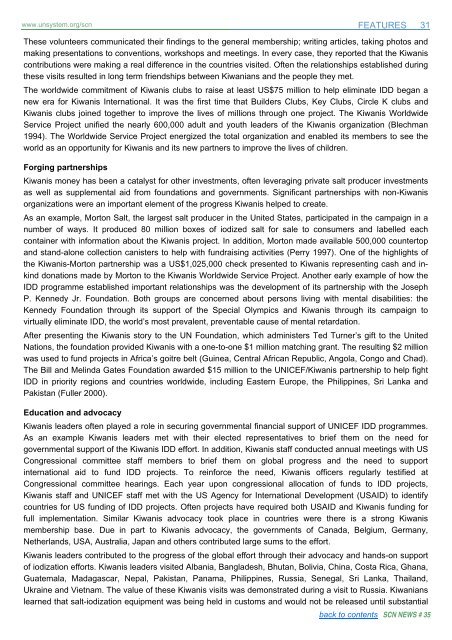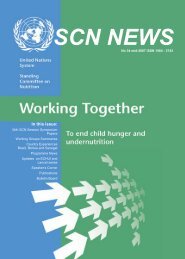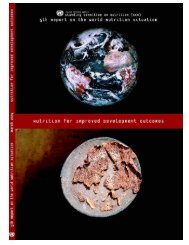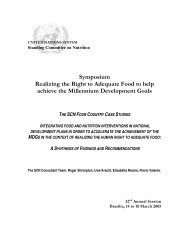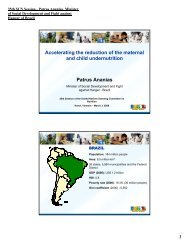Universal Salt Iodization (USI) - FTP Directory Listing
Universal Salt Iodization (USI) - FTP Directory Listing
Universal Salt Iodization (USI) - FTP Directory Listing
- No tags were found...
Create successful ePaper yourself
Turn your PDF publications into a flip-book with our unique Google optimized e-Paper software.
www.unsystem.org/scn FEATURES 31These volunteers communicated their findings to the general membership; writing articles, taking photos andmaking presentations to conventions, workshops and meetings. In every case, they reported that the Kiwaniscontributions were making a real difference in the countries visited. Often the relationships established duringthese visits resulted in long term friendships between Kiwanians and the people they met.The worldwide commitment of Kiwanis clubs to raise at least US$75 million to help eliminate IDD began anew era for Kiwanis International. It was the first time that Builders Clubs, Key Clubs, Circle K clubs andKiwanis clubs joined together to improve the lives of millions through one project. The Kiwanis WorldwideService Project unified the nearly 600,000 adult and youth leaders of the Kiwanis organization (Blechman1994). The Worldwide Service Project energized the total organization and enabled its members to see theworld as an opportunity for Kiwanis and its new partners to improve the lives of children.Forging partnershipsKiwanis money has been a catalyst for other investments, often leveraging private salt producer investmentsas well as supplemental aid from foundations and governments. Significant partnerships with non-Kiwanisorganizations were an important element of the progress Kiwanis helped to create.As an example, Morton <strong>Salt</strong>, the largest salt producer in the United States, participated in the campaign in anumber of ways. It produced 80 million boxes of iodized salt for sale to consumers and labelled eachcontainer with information about the Kiwanis project. In addition, Morton made available 500,000 countertopand stand-alone collection canisters to help with fundraising activities (Perry 1997). One of the highlights ofthe Kiwanis-Morton partnership was a US$1,025,000 check presented to Kiwanis representing cash and inkinddonations made by Morton to the Kiwanis Worldwide Service Project. Another early example of how theIDD programme established important relationships was the development of its partnership with the JosephP. Kennedy Jr. Foundation. Both groups are concerned about persons living with mental disabilities: theKennedy Foundation through its support of the Special Olympics and Kiwanis through its campaign tovirtually eliminate IDD, the world’s most prevalent, preventable cause of mental retardation.After presenting the Kiwanis story to the UN Foundation, which administers Ted Turner’s gift to the UnitedNations, the foundation provided Kiwanis with a one-to-one $1 million matching grant. The resulting $2 millionwas used to fund projects in Africa’s goitre belt (Guinea, Central African Republic, Angola, Congo and Chad).The Bill and Melinda Gates Foundation awarded $15 million to the UNICEF/Kiwanis partnership to help fightIDD in priority regions and countries worldwide, including Eastern Europe, the Philippines, Sri Lanka andPakistan (Fuller 2000).Education and advocacyKiwanis leaders often played a role in securing governmental financial support of UNICEF IDD programmes.As an example Kiwanis leaders met with their elected representatives to brief them on the need forgovernmental support of the Kiwanis IDD effort. In addition, Kiwanis staff conducted annual meetings with USCongressional committee staff members to brief them on global progress and the need to supportinternational aid to fund IDD projects. To reinforce the need, Kiwanis officers regularly testified atCongressional committee hearings. Each year upon congressional allocation of funds to IDD projects,Kiwanis staff and UNICEF staff met with the US Agency for International Development (USAID) to identifycountries for US funding of IDD projects. Often projects have required both USAID and Kiwanis funding forfull implementation. Similar Kiwanis advocacy took place in countries were there is a strong Kiwanismembership base. Due in part to Kiwanis advocacy, the governments of Canada, Belgium, Germany,Netherlands, USA, Australia, Japan and others contributed large sums to the effort.Kiwanis leaders contributed to the progress of the global effort through their advocacy and hands-on supportof iodization efforts. Kiwanis leaders visited Albania, Bangladesh, Bhutan, Bolivia, China, Costa Rica, Ghana,Guatemala, Madagascar, Nepal, Pakistan, Panama, Philippines, Russia, Senegal, Sri Lanka, Thailand,Ukraine and Vietnam. The value of these Kiwanis visits was demonstrated during a visit to Russia. Kiwanianslearned that salt-iodization equipment was being held in customs and would not be released until substantialback to contents SCN NEWS # 35


